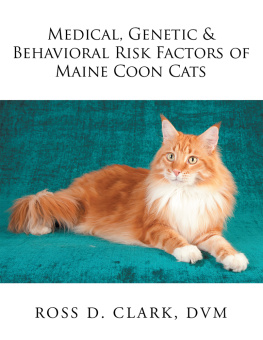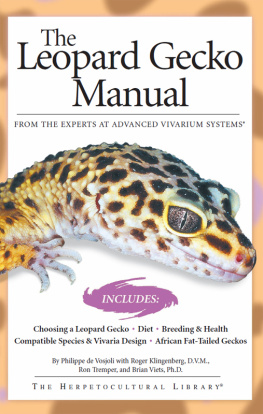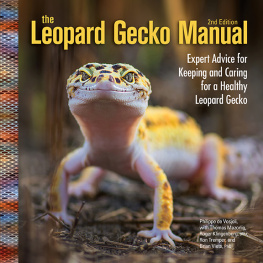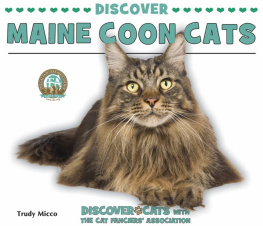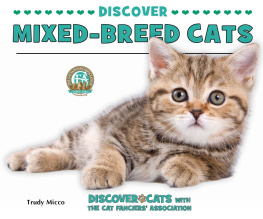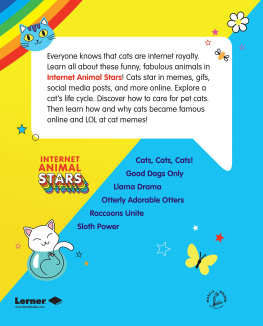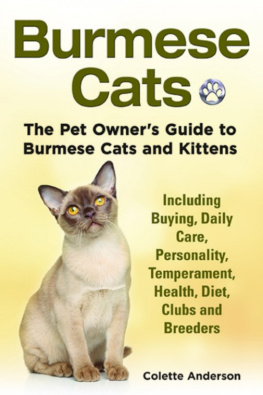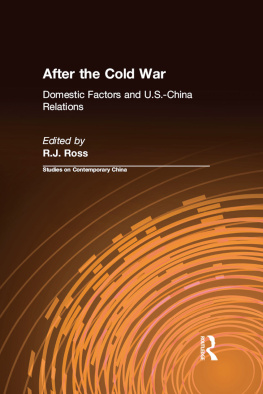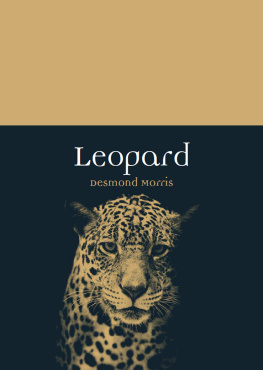MEDICAL, GENETIC & BEHAVIORAL RISK FACTORS OF MAINE COON CATS
BY: ROSS D. CLARK, DVM
H. DAVID HAYNES, DVM LEAD RESEARCH
AND EDITORIAL ASSISTANT
TERRY SUE CLARK, DVM SPECIAL EDITOR, FIRST EDITION
SUSAN S. GAFFNEY, DVM SPECIAL EDITOR, FIRST EDITION
ART J. QUINN, DVM, DACVO PROFESSOR EMERITUS, OKLAHOMA STATE UNIVERSITY CENTER FOR VETERINARY HEALTH SCIENCES, CONSULTING EDITOR, FIRST EDITION
GERI HIBBLEN JACKSON PHOTO ACQUISITIONS
Copyright 2017 by ROSS D. CLARK, DVM. 671448
ISBN: Softcover 978-1-5035-6054-3
EBook 978-1-5035-6053-6
All rights reserved. No part of this book may be reproduced or transmitted in any form or by any means, electronic or mechanical, including photocopying, recording, or by any information storage and retrieval system, without permission in writing from the copyright owner.
Rev. date: 01/23/2017
Xlibris
1-888-795-4274
www.Xlibris.co m
MEDICAL, GENETIC &
BEHAVIORAL RISK FACTORS OF
MAINE COON CATS
INSIDE:
I.ORIGIN AND HISTORY
II.DESCRIPTION
III.SHOW RING REQUIREMENTS
IV.CARE AND GROOMING
V.BEHAVIORAL TRAITS
VI.RECOGNIZED RISK FACTORS IN MAINE COON CATS
CARDIOVASCULAR-HEMATOLOGICAL-RESPIRATORY
DERMATOLOGIC
GASTROINTESTINAL
MUSCULOSKELETAL
NEUROLOGICAL
UROGENITAL
VII. MISCELLANEOUS FACTS AND RESOURCES
GENETIC TESTS
REGISTRIES
BY: ROSS D. CLARK, DVM
PREFACE
This book provides you with a through description and positive attributes of this breed including origin, purpose, history, normal heights and weights, acceptable colors and behavioral traits. Our books differ from most books on cat breeds because this book also provides you with a comprehensive and authoritative source of all the known predisposed hereditary health syndromes for the breed. You will find extensive references for each problem described. We also provide addresses of registries for this breed and a list of laboratories and organizations that can provide professional help and information.
After having written extensively about the differences in purebred dogs, I have turned my attention to purebred cats. The dog is the worlds most physically diverse species with over 400 different breeds recognized worldwide. Sizes range from a three pound Chihuahua to the 200 pound Irish wolfhound. Coat types range from the curly-coated Poodle to the hairless Xoloitzcuintli. Pedigreed cats, on the other hand have less variation in size and type with the largest breeds, the Maine Coon Cat and the Ragdoll weighing up to 20 pounds and the diminutive Singapura weighing only six pounds. Head shape shows much more diversity including the long, sleek head of the Siamese to the round massive head of the Persian. Coat type also has extensive varieties from the long thick double coat of the Himalayan to the short tight curl of the Devon Rex to no hair at all in the Sphynx and Donskoy. Diversity in cats appears to be less about size and function and more about coat, color and conformation.
Classification of cat breeds varies by registry and fanciers. The Governing Council of the Cat Fancy (GCCF), the main registry in the United Kingdom divides the breeds into groups based on coat type and origin; these include: Persian group, Semi-longhair group, British group, Foreign group, Burmese group, Oriental group and Siamese group. At present up to seventy-three different breeds of cat have been recognized by one registry but most registries recognize only 40 to 50.
It may appear that some breeds are more predisposed to genetic problems than others but this may be a factor of time and numbers. Established breeds like the Siamese and Persian represent a large population and have been bred by cat fanciers for over a century allowing for the recognition of certain characteristics and health problems. It may be noted that the majority of the problems noted in purebred cats also can be found in random bred cats known as Domestic shorthairs.
Conscientious cat breeders have recognized hereditary problems in their cats for years and have attempted to eliminate them through selective breeding. Since some of these problems do not appear until the cat is older, removing cats carrying a certain trait from a breeding program has been difficult. Now with the sequencing of the feline genome it is possible to locate mutations causing these problems through DNA testing of breeding stock. Work by Drs. Leslie Lyons and Barbara Gandolfi of the Feline Comparative Genetics Laboratory at the University of Missouri, Dr. Kathryn Meurs of the University of North Carolina and Dr. Niels Pedersen of the University of California, Davis and others have led the way in feline genetics making it possible to detect carriers of genetic diseases and eliminate them from breeding programs.
I have combined information from breeders, feline registries, veterinarians and genetic researchers to create a concise description of the physical, behavioral, medical and genetic aspects of this breed of cat.
This book will provide veterinarians, researchers, pet owners and breeders with a comprehensive guide to all the known problems veterinarians and cat owners should consider during pet selection and throughout each life stage of our feline friends.
Ross D. Clark, DVM
References
1. Cat Breeds; Governing Council of the Cat Fancy: www.gccfcats.org/Cat-breeds
2. Verhoef-Verhalen, Esther J. J. The Complete Encyclopedia of Cats Edison, NJ, Chartwell Books, 2005
TABLE OF CONTENTS
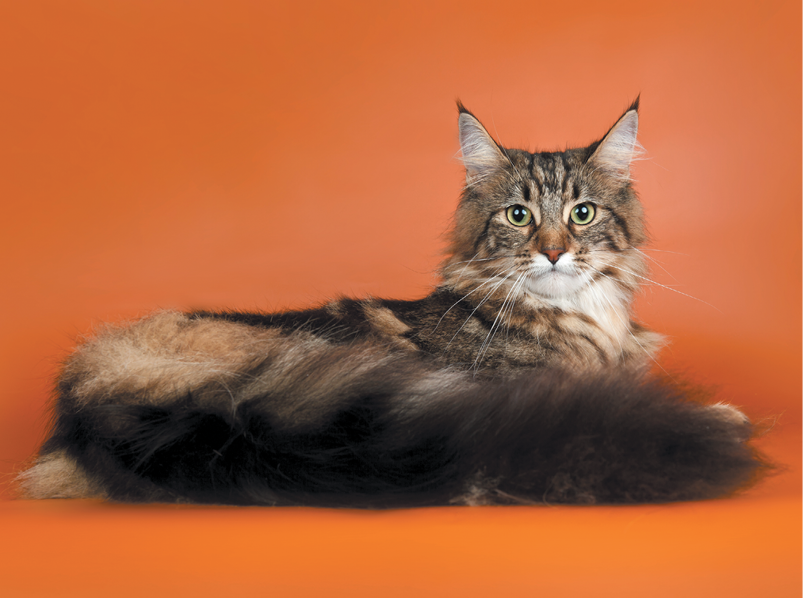
Maine Coon Cat showing a beautiful tail
This native of Maine is probably one of the oldest natural breeds living in North America. There are many stories and theories that explain how this longhaired beauty came to be. Although biologically impossible, some believed the Maine Coon evolved from breeding between semi-wild domestic cats and raccoons. This would explain the raccoon-like coloring and bushy, long tail. Another story claims that Marie Antoinette shipped her Maine Coons to the United States for protection during the French Revolution. It has also been suggested that the breed was brought to America by the Vikings. The similarity between the Main Coon and the Norwegian Forest Cat lends credence to that claim. Maine Coon cats were a favorite of the late actress Bette Davis. In 2014 the Maine Coon Cat ranked 3 rd in CFA registration.
COLOR : Although the brown tabby is the most popular, they can be any color with the exceptions of chocolate, lavender and Siamese patterns.
APPEARANCE : Initially, the Maine Coon was a working cat with great rodent-hunting abilities. This powerful, strong animal is very large and can withstand a harsh climate. The head is medium long with squareness to the muzzle. Cheekbones are high. Chin is firm and in line with the nose and upper lip. The nose is medium long with a slight concavity when viewed in profile. The ears are large, well-tufted and wide at the base. The ears taper to appear pointed and are set high and well apart. The eyes are large, expressive and wide set. They are slightly oblique setting with a slant toward the outer base of the ear. The neck is medium long. The body is muscular and broad-chested. Maine Coon cats are medium-to-large-sized cats. Males average 12 to 15 pounds with some reaching 20 pounds. Females are generally smaller than males, averaging 9-12 pounds. The body should be long with all parts in proportion to create a well-balanced rectangular appearance. The heavy and shaggy coat is longer on the stomach, britches and tail, and shorter on the shoulders. The coat appears silky and flowing and a frontal ruff is desired.
Next page
